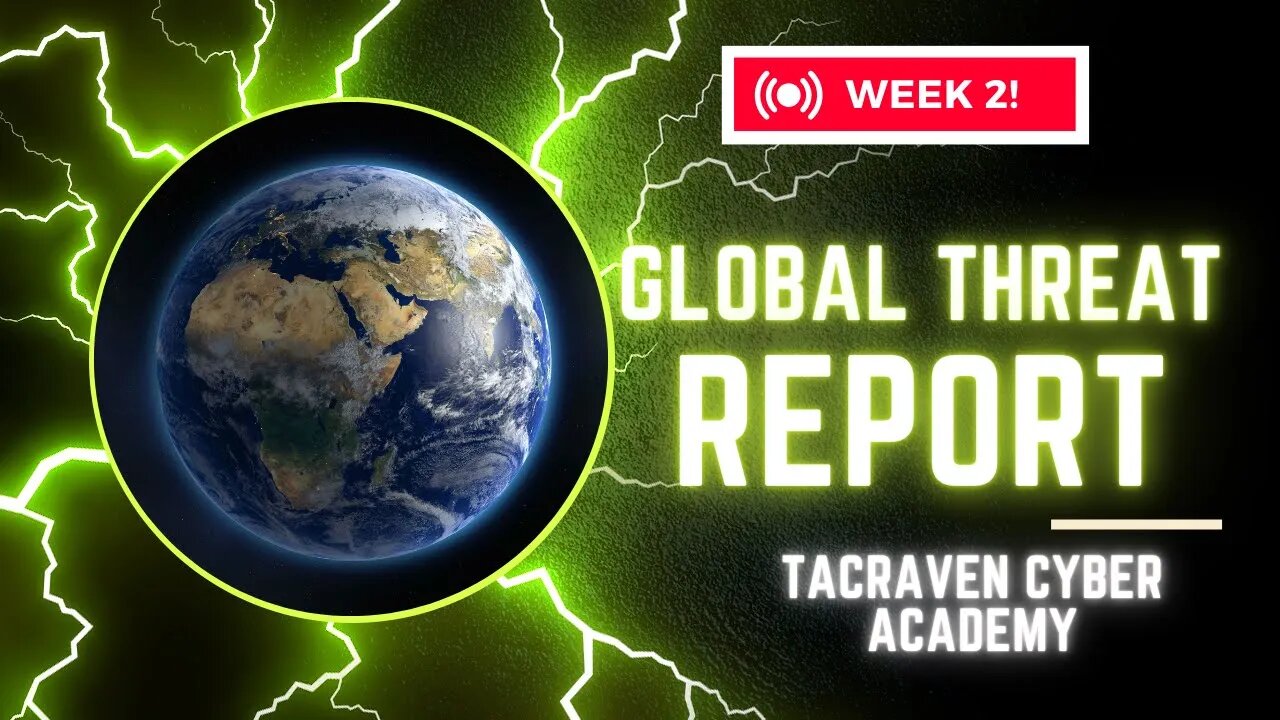Premium Only Content

Cyber Global Threat Report Part II
A global cyber threat report is a comprehensive document that provides an overview of the current state of cybersecurity threats and risks on a global scale. This week's big focus is going to be on Russia and Ukraine along with the effects that the war has had on the rest of the world!
As for the report generated by crowdstrike, you will see that these reports are typically compiled by cybersecurity organizations, government agencies, or industry experts and are intended to help businesses, governments, and individuals understand the evolving landscape of cyber threats. Below is a description of what you might find in a typical global cyber threat report:
1. Executive Summary: The report often begins with an executive summary that provides a high-level overview of the key findings, trends, and recommendations. This section is designed for busy decision-makers who need a quick understanding of the report's main points.
2. Threat Landscape Analysis: The report will include an in-depth analysis of the current cyber threat landscape, including details about the types of threats that are prevalent, such as malware, ransomware, phishing attacks, DDoS attacks, and more. It may also discuss the tactics, techniques, and procedures (TTPs) used by cybercriminals.
3. Emerging Threats: Global cyber threat reports typically highlight emerging threats and vulnerabilities that organizations should be aware of. This can include discussions of zero-day exploits, new attack vectors, or vulnerabilities in popular software and hardware.
4. Attack Trends: Reports often provide statistics and data on recent cyberattacks, including the industries most targeted, the methods used by attackers, and the impact of these attacks. This information can help organizations understand where they may be vulnerable.
5. Nation-State Activities: Information about cyber activities attributed to nation-states or state-sponsored groups is a common component of global cyber threat reports. This includes discussions of cyber espionage, cyber warfare, and political hacking.
6. Vulnerabilities and Patch Management: A report may include information on known vulnerabilities in software and hardware, along with recommendations for patching and mitigation strategies.
7. Industry-Specific Threats: Some reports may delve into threats specific to certain industries, such as healthcare, finance, or critical infrastructure. These industries often face unique cyber risks.
8. Regional Insights: The report may provide regional or country-specific insights, highlighting cyber threat trends and incidents in different parts of the world. This can be useful for organizations with global operations.
9. Recommendations and Best Practices: To help organizations protect themselves against cyber threats, global cyber threat reports typically include a section with recommendations and best practices for enhancing cybersecurity. This may cover areas such as employee training, incident response planning, and security technology adoption.
10. Case Studies: Real-world case studies of significant cyber incidents may be included to illustrate the potential impact of cyber threats and the lessons that can be learned from them.
11. Legal and Regulatory Developments: Reports may also touch on legal and regulatory changes related to cybersecurity, as these can have implications for how organizations should approach their cybersecurity efforts.
12. Future Predictions: Some reports conclude with predictions or forecasts for the future of cyber threats, helping organizations prepare for upcoming challenges.
Global cyber threat reports serve as valuable resources for organizations and individuals seeking to understand the evolving cyber threat landscape and take proactive measures to protect themselves against potential risks. They are typically updated regularly to reflect the changing nature of cyber threats and the cybersecurity landscape.
-
 1:02:49
1:02:49
TheCrucible
2 hours agoThe Extravaganza! EP: 70 (12/04/25)
37.3K5 -
 2:59:04
2:59:04
Redacted News
3 hours agoBREAKING! PIPE BOMB SUSPECT BRIAN COLE ARRESTED, FBI COVER-UP GOES NUCLEAR | Redacted News
122K44 -
 35:24
35:24
Stephen Gardner
2 hours ago🔥Tucker's BOMBSHELL warning + Trump FBI Makes BIG ARREST!!
20.3K25 -
 1:16:48
1:16:48
vivafrei
4 hours agoFBI Announces ARREST of Suspected Pipe Bomber! Judge Boasberg Should be IMPEACHED! & MORE!
82.4K55 -
 34:26
34:26
Misfits Mania
8 hours ago $14.22 earnedMISFITS MANIA: Launch Press Conference
152K23 -
 33:29
33:29
Donald Trump Jr.
7 hours agoLive With FBI Director Kash Patel, Breaking News!! | Triggered Ep.297
241K240 -
 1:22:59
1:22:59
The Quartering
5 hours agoJ6 Pipe Bomber Arrested, Candace Owens TPUSA Debate Predictions & My Staff Caused A Lawsuit!
107K62 -
 LIVE
LIVE
Dr Disrespect
8 hours ago🔴LIVE - DR DISRESPECT - WARZONE x BLACK OPS 7 - SEASON 1 INTEGRATION
955 watching -
 26:36
26:36
Jasmin Laine
3 hours agoTrump SILENCES Liberal Canada—CEO’s Oval Office Bombshell STUNS Ottawa
12.7K12 -
 27:03
27:03
The Kevin Trudeau Show Limitless
1 day agoThey're Not Hiding Aliens. They're Hiding This.
25.5K34